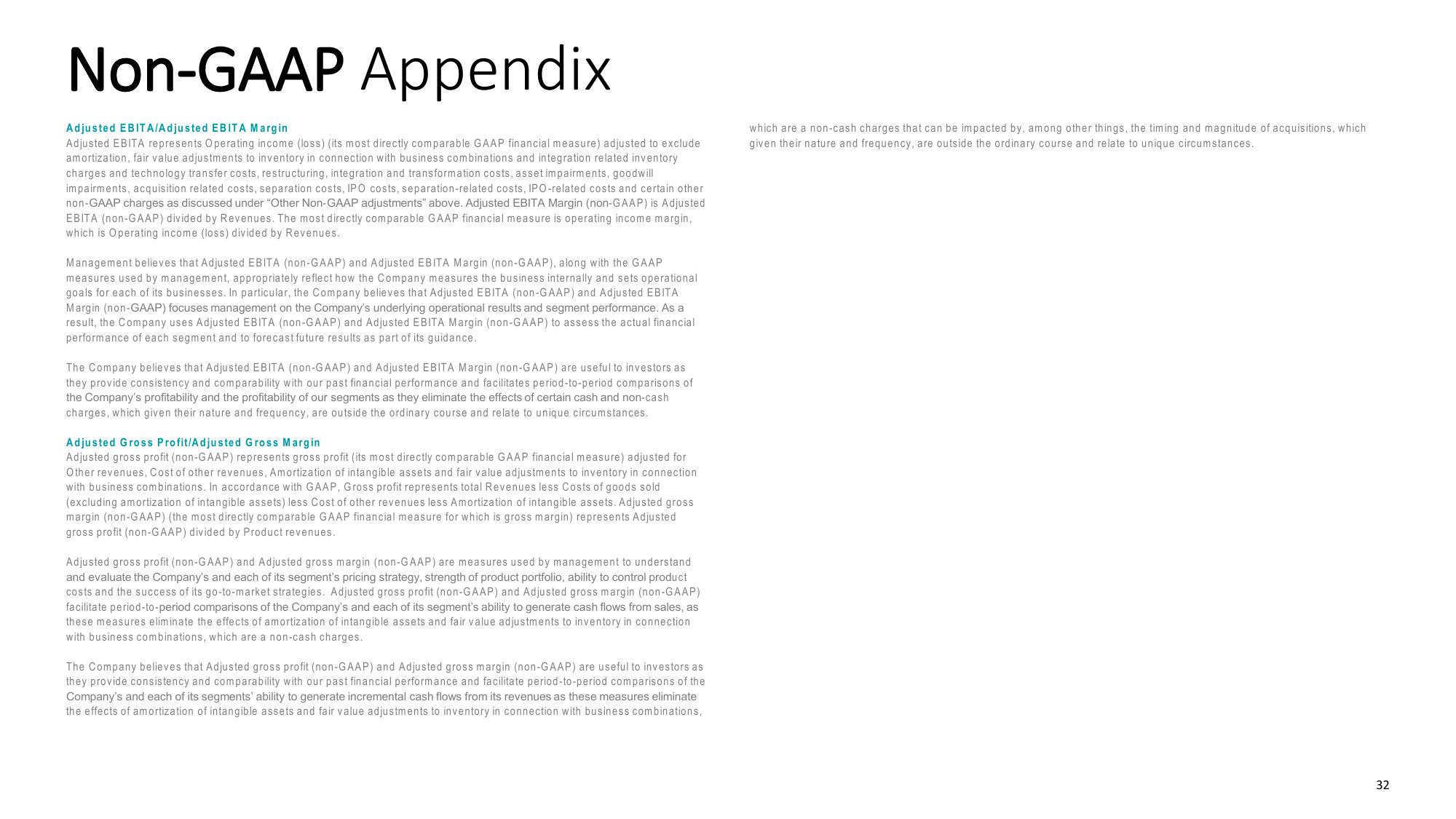Bausch+Lomb Results Presentation Deck
Non-GAAP Appendix
Adjusted EBITA/Adjusted EBITA Margin
Adjusted EBITA represents Operating income (loss) (its most directly comparable GAAP financial measure) adjusted to exclude
amortization, fair value adjustments to inventory in connection with business combinations and integration related inventory
charges and technology transfer costs, restructuring, integration and transformation costs, asset impairments, goodwill
impairments, acquisition related costs, separation costs, IPO costs, separation-related costs, IPO-related costs and certain other
non-GAAP charges as discussed under "Other Non-GAAP adjustments" above. Adjusted EBITA Margin (non-GAAP) is Adjusted
EBITA (non-GAAP) divided by Revenues. The most directly comparable GAAP financial measure is operating income margin,
which is Operating income (loss) divided by Revenues.
Management believes that Adjusted EBITA (non-GAAP) and Adjusted EBITA Margin (non-GAAP), along with the GAAP
measures used by management, appropriately reflect how the Company measures the business internally and sets operational
goals for each of its businesses. In particular, the Company believes that Adjusted EBITA (non-GAAP) and Adjusted EBITA
Margin (non-GAAP) focuses management on the Company's underlying operational results and segment performance. As a
result, the Company uses Adjusted EBITA (non-GAAP) and Adjusted EBITA Margin (non-GAAP) to assess the actual financial
performance of each segment and to forecast future results as part of its guidance.
The Company believes that Adjusted EBITA (non-GAAP) and Adjusted EBITA Margin (non-GAAP) are useful to investors as
they provide consistency and comparability with our past financial performance and facilitates period-to-period comparisons of
the Company's profitability and the profitability of our segments as they eliminate the effects of certain cash and non-cash
charges, which given their nature and frequency, are outside the ordinary course and relate to unique circumstances.
Adjusted Gross Profit/Adjusted Gross Margin
Adjusted gross profit (non-GAAP) represents gross profit (its most directly comparable GAAP financial measure) adjusted for
Other revenues, Cost of other revenues, Amortization of intangible assets and fair value adjustments to inventory in connection
with business combinations. In accordance with GAAP, Gross profit represents total Revenues less Costs of goods sold
(excluding amortization of intangible assets) less Cost of other revenues less Amortization of intangible assets. Adjusted gross
margin (non-GAAP) (the most directly comparable GAAP financial measure for which is gross margin) represents Adjusted
gross profit (non-GAAP) divided by Product revenues.
Adjusted gross profit (non-GAAP) and Adjusted gross margin (non-GAAP) are measures used by management to understand
and evaluate the Company's and each of its segment's pricing strategy, strength of product portfolio, ability to control product
costs and the success of its go-to-market strategies. Adjusted gross profit (non-GAAP) and Adjusted gross margin (non-GAAP)
facilitate period-to-period comparisons of the Company's and each of its segment's ability to generate cash flows from sales, as
these measures eliminate the effects of amortization of intangible assets and fair value adjustments to inventory in connection
with business combinations, which are a non-cash charges.
The Company believes that Adjusted gross profit (non-GAAP) and Adjusted gross margin (non-GAAP) are useful to investors as
they provide consistency and comparability with our past financial performance and facilitate period-to-period comparisons of the
Company's and each of its segments' ability to generate incremental cash flows from its revenues as these measures eliminate
the effects of amortization of intangible assets and fair value adjustments to inventory in connection with business combinations,
which are a non-cash charges that can be impacted by, among other things, the timing and magnitude of acquisitions, which
given their nature and frequency, are outside the ordinary course and relate to unique circumstances.
32View entire presentation